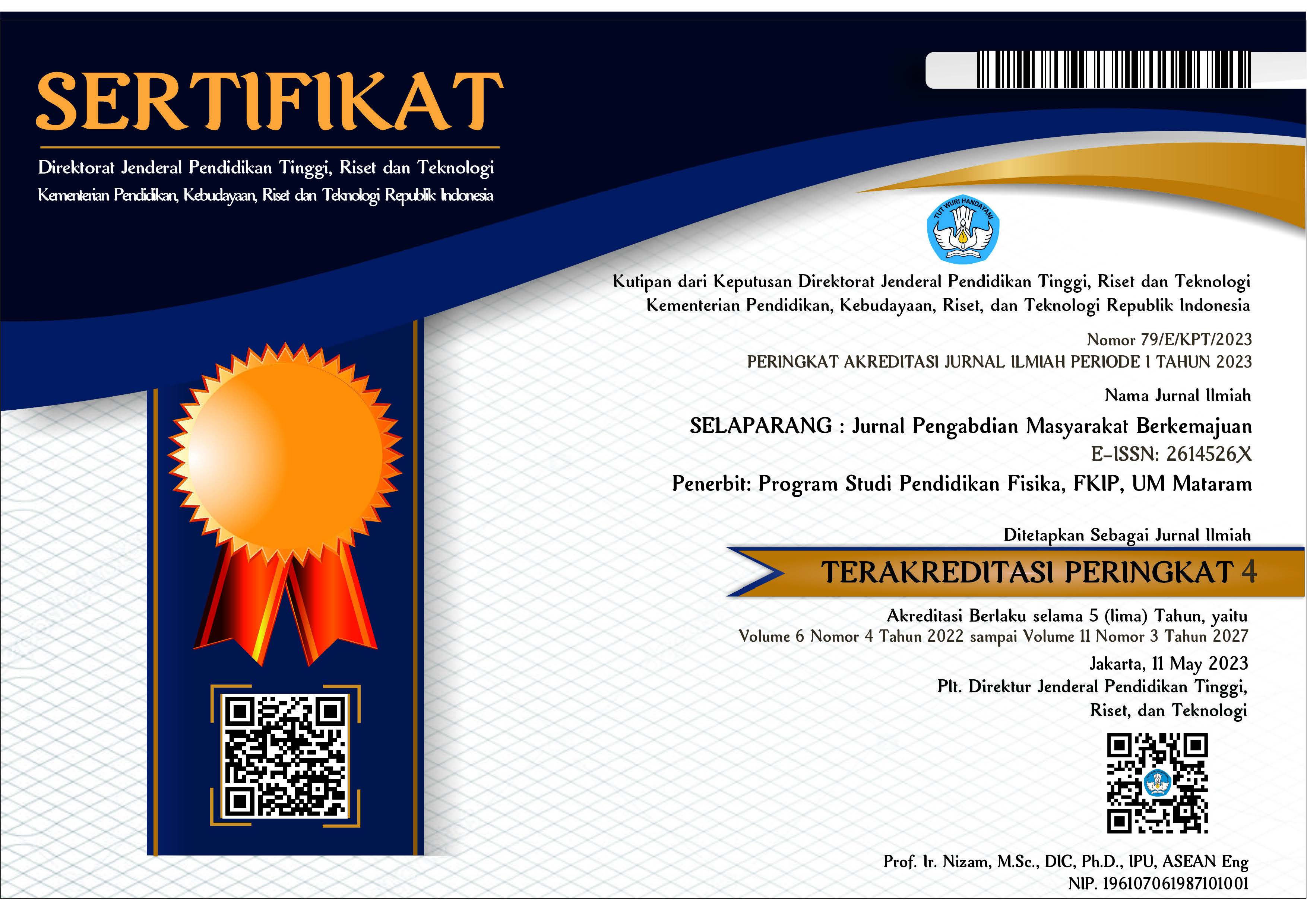PENGENALAN TEKNOLOGI BIOGAS SEBAGAI SUMBER ENERGI ALTERNATIF RAMAH LINGKUNGAN DI DESA TUBUHUE
Abstract
ABSTRAK
Desa Tubuhue merupakan salah satu daerah di Kecamatan Amanuban Barat, Kabupaten TTS. Desa Tubuhue berjarak ±96 KM dari Kota Kupang dan hanya dapat ditempuh dengan perjalanan darat dengan waktu tempuh ± 1,5 s/d 2,15 jam. Mayoritas masyarakatnya bermata pencaharian sebagai petani palawija dan peternak. Satu-satunya hasil pertanian andalan masyarakat desa Tubuhue diluar palawija adalah buah jagung, yang dipanen sekali dalam setahun pada bulan September. Pemahaman masyarakat akan potensi alam dan pola pikir yang hanya mengandalkan hasil alam yang telah ada/disediakan alam tanpa ada upaya pengembangan, menjadi penyebab utama keterpurukan ekonomi atau kemiskinan yang melanda hampir seluruh masyarakat Desa Tubuhue. didesa ini terdapat sumber mata air dan danau yang selalu menyediakan air meskipun pada musim kemarau. Namun sumber air yang terbilang maksimal ini tidak dimanfaatkan secara baik untuk kegiatan ekonomi produktif dan hanya semata-mata dimanfaatkan untuk kebutuhan MCK dan beberapa memanfaatkan untuk bertani sayur yang semata-mata untuk keperluan konsumsi. Limbah peternakan juga sama sekali tidak dimanfaatkan untuk sumber energi dan hanya sebagian yang dimanfaatkan sebagai kompos. Melalui program ini dapat memberikan pengetahuan dan pemahaman serta skill yang maksimal untuk dapat mengelola potensi yang dimiliki dengan pembuatan biogas dari kotoran ternak dalam meningkatan kesejahteraan hidup masyarakat di desa Tubuhue. Hasil dari program ini masyarakat mampu untuk memanfaatkan potensi limbah /kotoran ternak sebagai sumber energi terbarukan biogas.
Kata kunci: biogas; desa tubuhue; kotoran ternak.
ABSTRACT
Tubuhue Village is one of the areas in West Amanuban District, TTS Regency. The village of Tubuhue is ±96 KM from Kupang City and can only be reached by road with a travel time of ± 1.5 to 2.15 hours. The majority of the people make a living as secondary food farmers and ranchers. The only mainstay agricultural product for the people of Badanue village outside of palawija is corn, which is harvested once a year in September. The community's understanding of the potential of nature and a mindset that only relies on natural products that already exist by nature without any development efforts are the main causes of usage downturn or poverty that hit almost the entire community of Tubuhue Village. In this village, there are springs and lakes that always provide water even in the dry season. However, this maximum water source is not used properly for productive economic activities and is only used for toilet needs and some use it for vegetable farming which is solely for consumption purposes. Livestock waste is also not used as an energy source at all and only part of it is used as compost. Through this program, they can provide maximum knowledge and understanding as well as skills to be able to manage their potential by making biogas from livestock manure in improving the welfare of the community in the village of Tubuhue. The result of this program is that the community can take advantage of the potential of livestock waste as a renewable source of biogas energy.
Keywords: biogas energy; tubuhue village; livestock waste
Keywords
Full Text:
PDFReferences
Adityawarman, A. C., Salundik, & Lucia. (2015). Pengolahan Limbah Ternak Sapi Secara Sederhana di Desa Pattalasang Kabupaten Sinjai Sulawesi Selatan. Jurnal Ilmu Produksi dan Teknologi Hasil Pertanian, 3(3), 171 - 177
Al Seadi, T., Rutz, D., Janssen, R. and Drosg, B. (2013). Biomass resources for biogas production. I n. Wellinger A. (Eds) The Biogas Handbook. Woodhead Publishing. Oxford Cambridge Philadelphia New Delhi.
Budi Santoso, Irba U. Warsono, Daniel Y. Seseray, Purwaningsih. (2020). Pemanfaatan Kotoran Sapi Sebagai Sumber Energi Biogas di Kabupaten Teluk Bintuni Provinsi Papua Barat. Jurnal Pengabdian Kepada Masyarakat
Karno, Karno, dan Hery K. (2013). Panduan Praktis: Membuat Biogas Itu Mudah dan Mudah. Penerbit Forum Ilmiah Kesehatan (Forikes), Jakarta
Maulana Arifin, (2011). Study Of Biogas For Power Generation At Pesantren S Aung Balong Al-Barokah, Majalengka, West Java. Journal of Mechatronics, lectrical Power, and Vehicular Technology Vol. 02, No 2, pp 73-78, 2011.
Pertiwiningrum, A. (2016). Instalasi Biogas. CV. Kolom Cetak. Edisi 1
Pratiwi, I., Permatasari, R., & Homza, O. F. (2019). PEMANFAATAN LIMBAH KOTORAN TERNAK SAPI DENGAN REAKTOR BIOGAS DI KABUPATEN OGAN ILIR. IKRA-ITH ABDIMAS, 2(3), 1-10.
Razak, A., & Rahman, A. (2018, Mei). Analisis Hasil Rancang Bangun Alat Produksi Biogas dengan Bahan Baku Kotoran Ternak. Retrieved Agustus 20, 2020, from researchgate: https://www.researchgate.net/publication/332605072 ANALISIS HASIL RANCANG BANGUN ALAT PRODUKSI BIOGAS DENGANBAHAN_BAKU_KOTORAN_TERNAK
DOI: https://doi.org/10.31764/jpmb.v6i2.8679
Refbacks
- There are currently no refbacks.

This work is licensed under a Creative Commons Attribution-ShareAlike 4.0 International License.
______________________________________________________
Jurnal Selaparang
p-ISSN 2614-5251 || e-ISSN 2614-526X
EDITORIAL OFFICE:



















